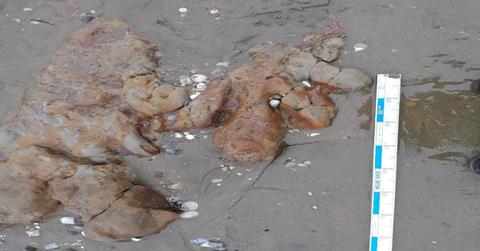125-Million-Year-Old Discovery: Giant Tracks Found in Britain's 'Dinosaur Capital'

Evidence has been found of more than 35 different kinds of dinosaurs on the beaches of the Isle of Wight in the English Channel.
Dinosaur footprints dating back 125 million years were found in a coastal part of the United Kingdom known as Britain's "dinosaur capital" for its prehistoric discoveries.
Engineers were working to keep the small island from flooding when they came upon the set of three-toed prehistoric prints, Knewz.com reported.
Scientists believe the fossilized footprints belonged to a "Mantellisaurus," a dinosaur that lived during the Early Cretaceous period and measured in at 23 feet: twice the length of an average car, according to the UK Environment Agency.
"We cannot be totally sure about a print’s identity, but the 3-toed feet makes it likely a Mantellisaurus was here, not just in other parts of the south coast where they were more common – or that’s what we thought until now," Dr. Martin Munt, curator of the Dinosaur Isle Museum, said.
The discovery apparently revealed that the area inhabited by this particular dino spanned further than previously thought.
"This represents a hugely important and significant discovery for the project," an engineering consultant said. "Finding the new footprints makes it clear that the land on which the dinosaurs walked is likely to stretch the whole length of Yaverland beach"
The large fossils were found in the Isle of Wight, an island in the English Channel just off the southern coast of England. Engineers uncovered the footprints while doing excavations to prevent coastal flooding in the area.
- Fierce Find: Perfectly Preserved Giant 'Underwater T. Rex' Discovered on British Beach
- Fishermen Dredged Up Sea Monster Nicknamed 'Nessie' off New Zealand Coast — but Tossed 30-Foot Carcass Overboard Because of Stench
- The Legend of the Loch Ness Monster: Do Recent Reports of Sea Serpent Sightings Prove Legend Is True?
The Isle of Wight, which Dr. Munt called the "richest dinosaur location in Europe," has been the site of prehistoric and dinosaur-related finds since the 1800s. The area was the "perfect habitat for dinosaurs," therefore generating a wealth of bones and fossils over millions of years.
In 1917, an entire Mantellisaurus skeleton was found on the isle, and put on display at the Natural History Museum. It is still one of the most complete dinosaur skeletons in the United Kingdom.
"Dinosaurs existing right where our team is working brings old and new together – the modern challenges of combatting climate change with a period of time we can only imagine," Nick Gray, the Environment Agency's flood and coastal risk manager said.
The dinosaur is believed to have had "large thumb spikes," which it used as its primary defense mechanism against predators, according to the UK Natural History Museum.
Never miss a story — sign up for the Front Page Detectives newsletter. Be on the scene the moment news breaks.
More than 35 different kinds of dinosaurs have been found on the beaches of the Isle of Wight, according to Dr. Munt, who said the area was once also crawling with critters like crocodiles, pterosaurs, amphibians, fish and invertebrates like insects and freshwater mussel.
The news of the discovery came days after Knewz.com reported that dinosaur bones worth $1 million were stolen from federal lands in Utah and sold overseas. Four people were charged with selling the fossils in an alleged international scheme that lasted five years.
Become a Front Page Detective
Sign up to receive breaking
Front Page Detectives
news and exclusive investigations.
